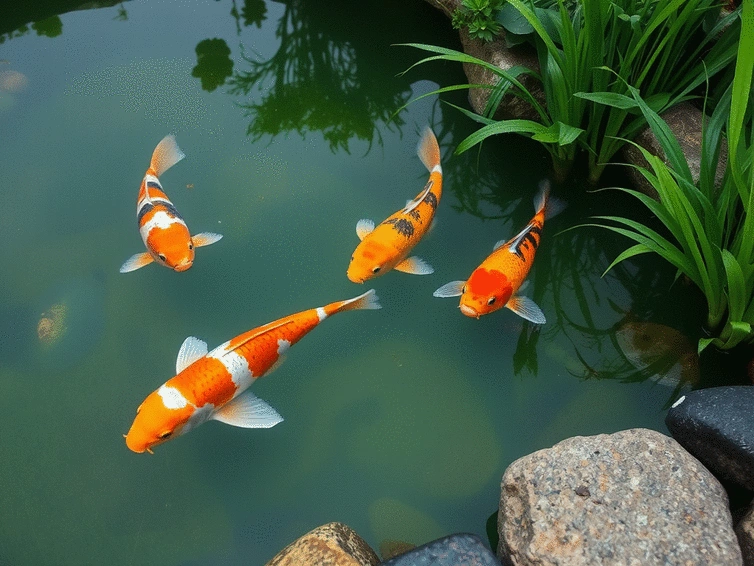
Materials for Durable Koi Ponds
Creating a koi pond is a thrilling journey that combines art and science. Did you know that a well-constructed koi pond can not only beautify your backyard but also nurture a vibrant aquatic ecosystem? Let’s explore the foundational elements that will ensure your pond flourishes for years to come.
What You Will Learn
- The importance of selecting high-quality materials to enhance the durability and longevity of your koi pond.
- Key design elements such as pond size, shape, and landscaping that contribute to a healthy koi habitat.
- How pond depth and shape affect water quality and the wellbeing of your koi fish.
- Essential insights on eco-friendly practices and materials that promote sustainability in pond construction.
- Creative accessories and enhancements that can elevate the aesthetic appeal of your koi pond.
Key Elements for Koi Pond Construction Success
Building a successful koi pond hinges on thoughtful design and material selection. Below, we highlight the crucial factors and material choices that contribute to a durable, healthy, and aesthetically pleasing aquatic environment.
Design FundamentalsEssential Elements of Koi Pond Design
- Size & Shape: Ample space for koi.
- Water Depth: Min. 3 ft for temperature stability.
- Landscaping: Shade & natural habitat.
Material SelectionKey Takeaways on Material Durability
- EPDM Liners: Flexible, long lifespan.
- Reinforced Polyethylene: Strength for various conditions.
- Concrete & Stone: Natural, enduring structure.
Understanding the Fundamentals of Koi Pond Construction
Creating a stunning koi pond is about more than just aesthetics; it’s about understanding the fundamentals of construction. With over a decade of experience, I’ve learned that the foundation of a successful pond lies in the details. Selecting the right materials and design elements can make all the difference in creating a thriving aquatic habitat.
As you embark on your koi pond journey, remember that these choices not only affect the beauty of your pond but also its health and longevity. Let’s dive into why choosing the right materials is crucial for your koi pond success!
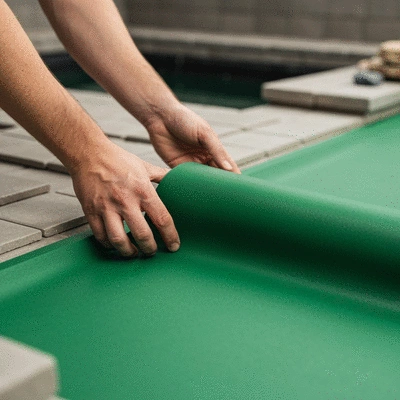
Why Choosing the Right Materials Matters for Your Koi Pond
The materials you select for your koi pond can significantly impact its durability and performance. Choosing the right ones ensures that your pond can withstand various environmental conditions and the wear and tear of nature. Here are some key reasons why material selection is vital:
- Durability: High-quality materials can resist algae growth and leaks over time.
- Water Quality: Materials should not leach harmful substances into your pond.
- Aesthetic Appeal: The right materials enhance the beauty of your pond and fit in with your landscape.
When I designed my first pond, I learned the hard way that skimping on materials could lead to costly repairs. Investing in good-quality materials pays off in the long run, ensuring you enjoy your koi pond for many years!
The Essential Elements of Koi Pond Design
Designing your koi pond involves more than just deciding where to place it in your yard. Several elements must come together to create an optimal environment for your fish. Here are some essential design elements to consider:
- Size and Shape: The pond should have enough space for your koi to swim freely.
- Water Depth: A minimum depth of 3 feet helps protect koi from temperature fluctuations, as highlighted by PetMD's guide on building a koi pond.
- Landscaping: Surrounding your pond with plants can provide shade and promote a natural habitat.
Each of these elements plays a critical role in your pond's ecosystem. I’ve found that thoughtful design can significantly enhance the health and happiness of your koi!
Exploring the Importance of Pond Depth and Shape in Construction
The depth and shape of your koi pond are not just for visual appeal; they are crucial for the overall health of your fish. A well-constructed pond allows for better water circulation, temperature regulation, and habitat complexity. Let’s explore why these factors matter:
- Pond Depth: Deeper ponds provide a stable temperature and protect koi from predators.
- Pond Shape: Irregular shapes create hiding spots and varied water flow, promoting a healthier environment. Experts at Reflections Water Gardens emphasize the importance of thoughtful pond design for koi well-being.
- Surface Area: A larger surface area allows for better gas exchange, essential for fish health.
In my experience, ponds that embrace varied depths and shapes not only look fantastic but also create a thriving ecosystem. When planning your pond, keep these factors in mind to give your koi the best possible home!
We Want to Hear From You!
As you embark on your koi pond journey, what challenges or questions do you have in mind? Share your thoughts below:
Summarizing Essential Insights for Koi Pond Construction
As we wrap up our exploration of koi pond construction, it's vital to reflect on the key aspects we've discussed. Building a beautiful and thriving koi pond is a rewarding endeavor, and understanding the fundamentals lays the groundwork for your success. Remember, the journey to a stunning aquatic environment starts with informed choices!
When it comes to material selection and design, consider both durability and aesthetics. The right materials will not only enhance the beauty of your pond but also ensure it stands the test of time. At Best Koi Ponds, we believe that every koi pond owner should feel confident about their choices!
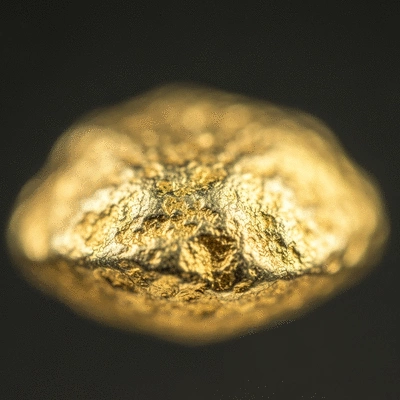
Key Takeaways on Material Selection for Durability
- EPDM liners are widely regarded for their flexibility and long lifespan, making them an excellent choice for most koi ponds.
- Reinforced polyethylene offers strength and resilience, ideal for varying weather conditions.
- For those seeking natural aesthetics, concrete and stone can create a stunning, enduring pond structure.
- Don’t overlook eco-friendly options, as they support sustainability while maintaining pond health!
These materials not only provide a solid foundation but also contribute to the overall health of your koi pond ecosystem. Keeping these takeaways in mind ensures your pond remains a vibrant and sustainable space for years to come.
Final Thoughts on Creating a Sustainable Koi Pond
Creating a sustainable koi pond is more than just picking materials—it's about fostering a lively habitat for your koi to thrive. A well-planned pond balances aesthetics and functionality, ensuring your fish have a safe and beautiful home. I often encourage pond owners to think about integrating plants and natural filtration systems to support this balance!
By investing in sustainable practices, such as using native plants and energy-efficient pumps, we can protect our environment and enjoy the beauty of koi ponds. Remember, sustainability in koi pond creation not only benefits the fish but also contributes positively to our shared ecosystem.
Encouraging Responsible Choices in Koi Pond Building
Making responsible choices in your koi pond project means considering the long-term impact of your decisions. As a koi enthusiast, I always emphasize the importance of high-quality materials and methods. This commitment will ensure your pond remains healthy and beautiful while minimizing maintenance costs in the future.
- Research local regulations to ensure compliance with environmental standards.
- Choose materials that are safe for aquatic life and won’t leach harmful substances.
- Consider the long-term effects of water management and landscaping on your pond ecosystem. As noted by Pond Trade Magazine, the evolution of koi pond construction emphasizes innovation for better aquatic environments.
By adopting a responsible mindset, you can contribute to a community of koi pond owners who prioritize both beauty and sustainability!
Exploring Pond Accessories and Enhancements for Aesthetics
As you finalize your koi pond construction, think about how accessories and enhancements can elevate the visual appeal of your aquatic haven. From vibrant aquatic plants to elegant fountains, these additions can transform a simple pond into a stunning focal point in your yard!
- Waterfalls can add soothing sounds while helping with water circulation.
- Floating plants like water lilies enhance beauty and provide shade for koi.
- Pond lights illuminate your pond at night, showcasing your koi in a magical way.
Incorporating these accessories not only enhances the aesthetics but also promotes a healthy environment for your fish. So go ahead, let your creativity flow and make your koi pond a true masterpiece!
Frequently Asked Questions About Koi Pond Construction
- Q: What is the ideal minimum depth for a koi pond?
- A: A minimum depth of 3 feet is recommended for a koi pond. This depth helps to maintain stable water temperatures, protecting koi from extreme fluctuations and providing a safe haven from predators.
- Q: Why is material selection so important for a koi pond?
- A: Choosing high-quality materials significantly impacts the pond's durability, water quality, and aesthetic appeal. Durable materials prevent leaks and resist algae growth, while non-toxic materials ensure the water remains safe for your koi. Proper material selection contributes to the pond's longevity and performance.
- Q: How do pond shape and depth affect koi health?
- A: Pond shape and depth are crucial for koi health. Deeper ponds offer temperature stability and protection from predators. Irregular shapes create varied water flow and hiding spots, enriching the koi's environment and promoting better water circulation. A larger surface area also facilitates essential gas exchange.
- Q: What are some eco-friendly practices for koi pond construction?
- A: Eco-friendly practices include using sustainable materials like EPDM liners or reinforced polyethylene, integrating native plants for natural filtration, and employing energy-efficient pumps. These choices promote a balanced ecosystem, reduce environmental impact, and contribute to the pond's overall sustainability.
- Q: What accessories can enhance a koi pond's aesthetics and functionality?
- A: Accessories such as waterfalls provide soothing sounds and improve water circulation. Floating plants like water lilies offer beauty and shade. Pond lights illuminate the pond at night, highlighting your koi. These enhancements not only boost visual appeal but also contribute to a healthier aquatic environment.
Recap of Key Points
- Material Selection: Invest in high-quality materials such as EPDM liners and reinforced polyethylene for durability and water quality.
- Pond Design Elements: Consider size, shape, and depth to create a healthy environment for koi, with a minimum depth of 3 feet.
- Importance of Depth and Shape: Deeper and irregularly shaped ponds enhance water circulation and provide shelter for koi.
- Sustainability Practices: Use eco-friendly materials and native plants to foster a balanced ecosystem.
- Enhance Aesthetics: Add accessories like waterfalls and pond lights to improve both beauty and functionality.

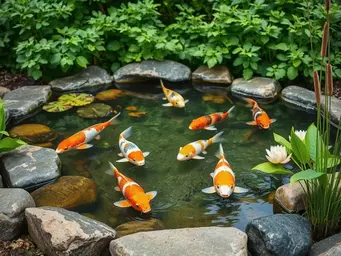
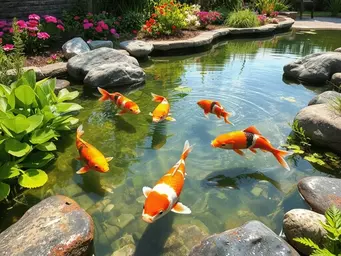
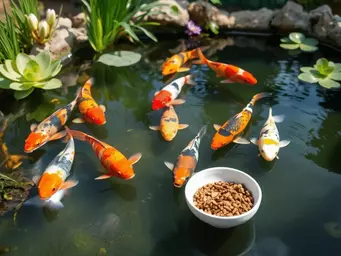
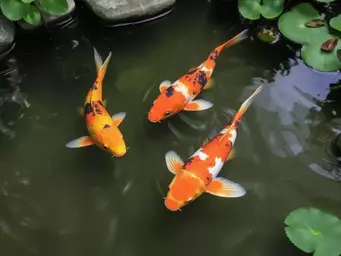
Koi Pond Budgeting Made Simple
Building a Self-Sustaining Koi Pond
Koi Care Tips for Every Season
Managing Koi Pond Chemical Levels
Koi Pond Building Mistakes to Avoid